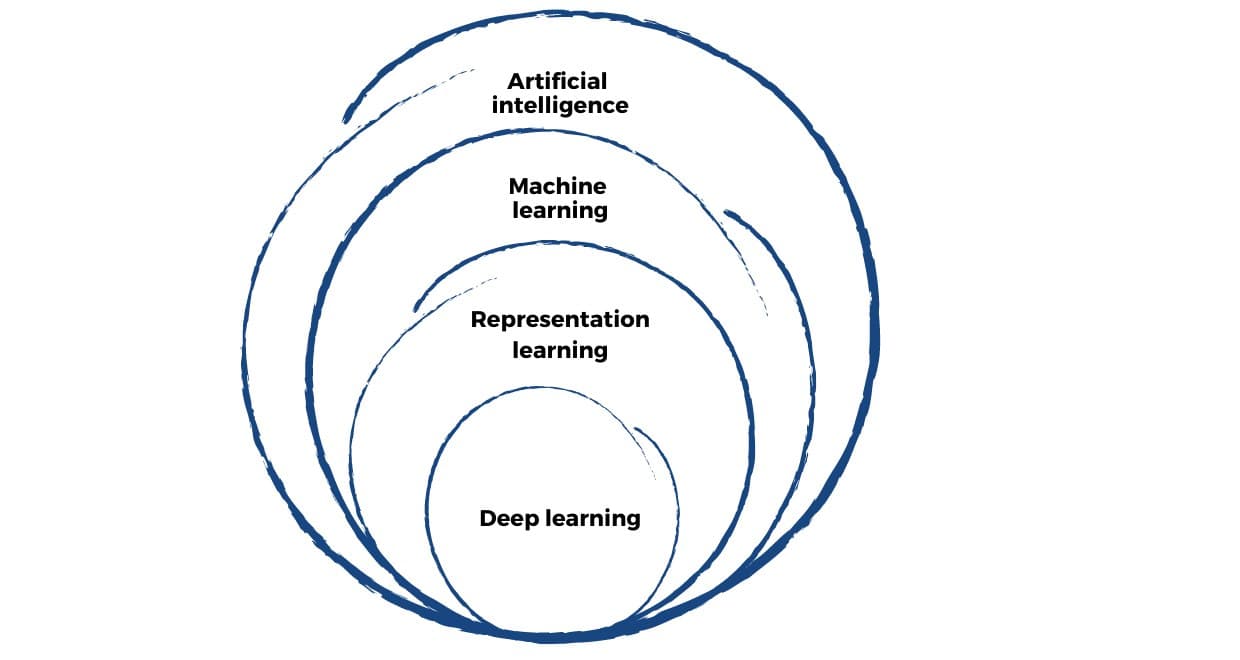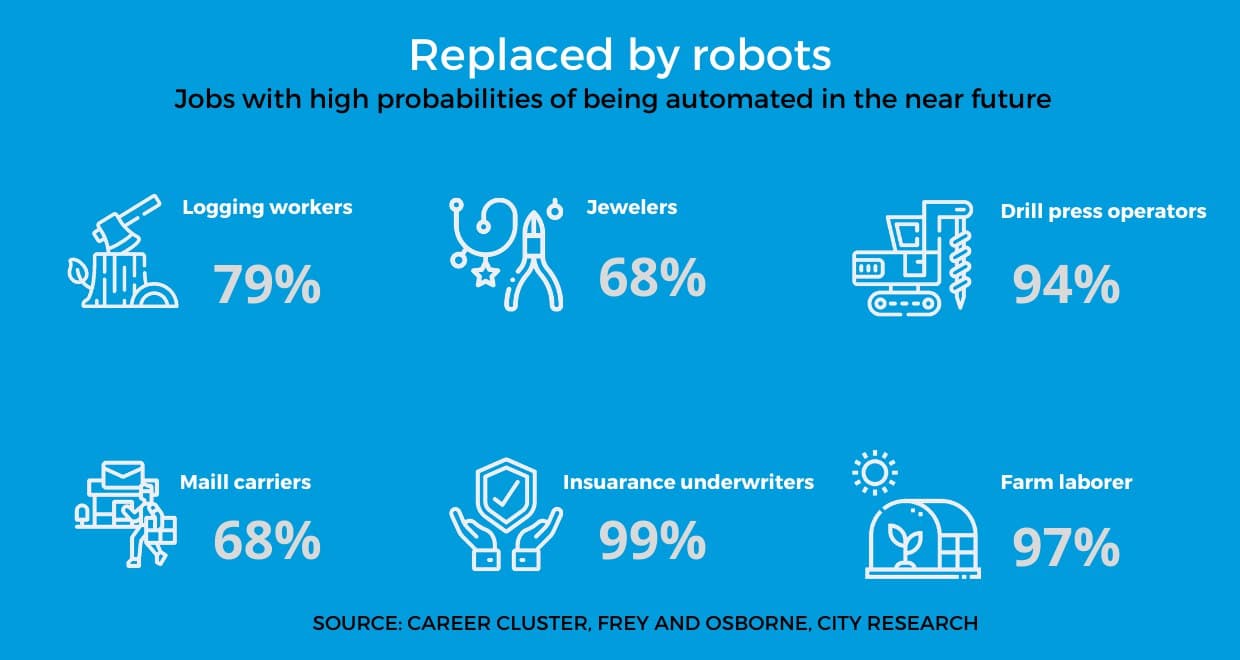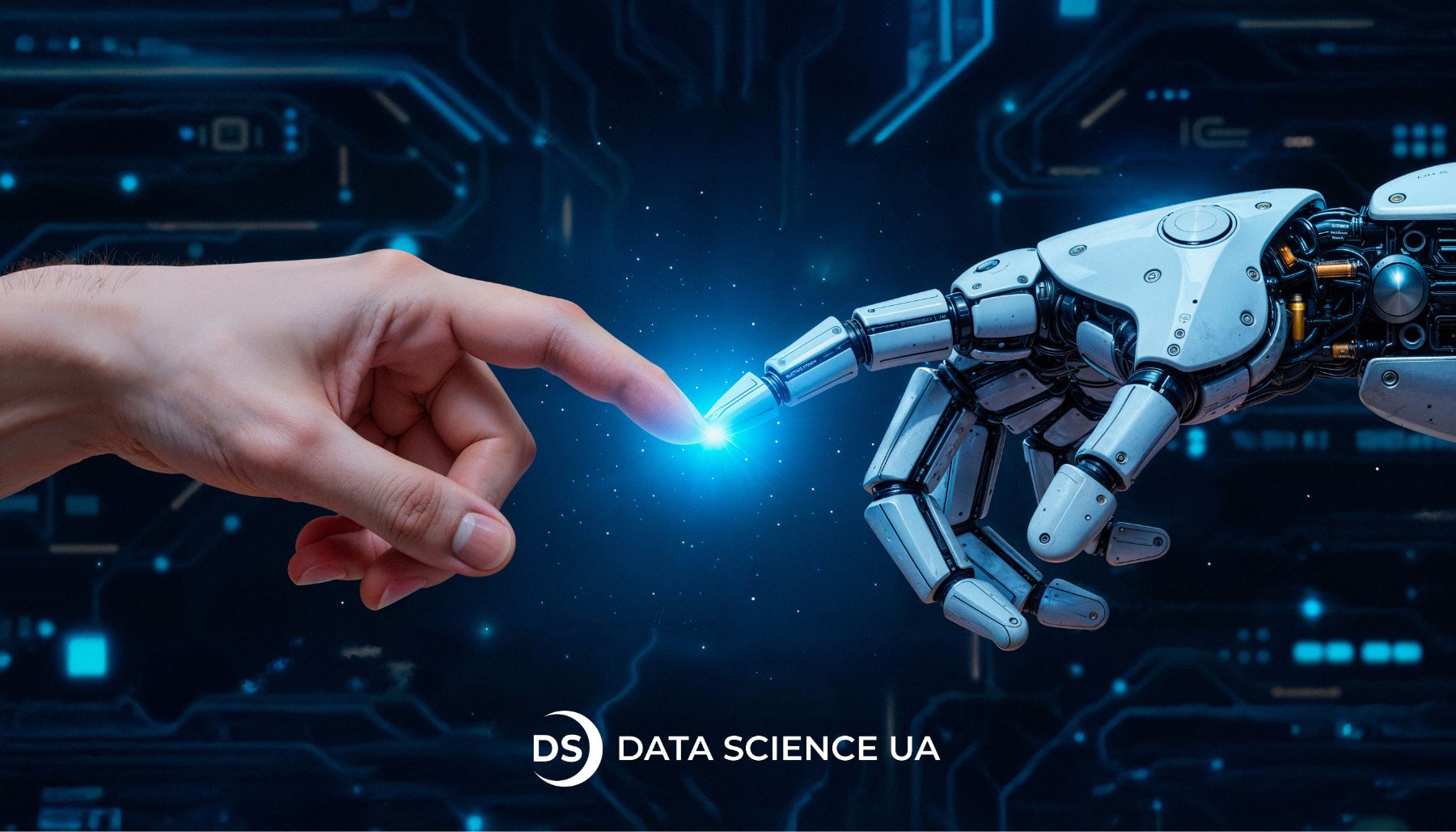AI trends 2025 – Top Innovations
AI, or Artificial Intelligence, is a field of computer science concerned with building smart machines. That is, machines capable of performing tasks in a way humans do.
AI has no standard definition among AI researchers. It is an expansive science that includes different approaches and techniques, like machine learning and deep learning, which have been actively developing lately and have achieved genuinely incredible results.
 AI is a broad concept that includes multiple subfields
AI is a broad concept that includes multiple subfields
Self-driving cars, virtual assistants, grammar checkers, face recognition systems are only a few of the many AI achievements and now many of us expect what else can be presented among future AI trends. Technology is continuously advancing, and AI is no exception. We can expect significant transformations very soon that may change everything. So, what are the top AI trends in 2025?
Cloud Computing
Probably, the most promising in our list of AI trends of the nearest future is cloud adoption. Cloud platforms (GCP, AWS, Microsoft Azure) are getting more and more popular because they allow for efficient and effective solutions. Data storing, computing, and scaling can be done easily. More memory or faster processors can be added with a click of a button.
Many cloud providers offer pre-trained models for various machine learning projects. Such models as BERT or GPT-2 contain millions of parameters, and it is almost impossible to train them locally. Luckily, they are already available and ready to use, along with many other AI applications. Google Cloud alone offers more than ten services. Among them: automatic translation, computer vision, machine learning solutions development, speech recognition, and many more.
 Ready to use object detection tool from Google Cloud
Ready to use object detection tool from Google Cloud
Edge Computing
On the other side of cloud computing, there is edge computing. This term refers to the process of bringing the computing as close to the source of data as possible. So, instead of using cloud solutions, all the computations are transferred to the local devices and servers. This reduces latency and bandwidth use and leads to better performance and lower costs.
Another benefit edge computing provides is additional security. As data is stored on the device, there is less chance of it being stolen or damaged in the cloud or along the way.
Edge computing is usually used in IoT, security systems, self-driving cars, medical devices, smartphones, etc. Your fitness tracker or smart vacuum cleaner are also examples of edge computing. Sending all the data to the cloud server and awaiting the results would be too long and too costly. Sometimes it may even be impossible because of a poor connection. Instead, all computations are carried out on the device itself.
Ethics
Several ethical dilemmas accompany the progress of AI. Some of them deal with the future of humanity – others with privacy and security.
One of the most critical issues raised by the development of AI is unemployment. It is a common opinion that automation and AI will take over, leaving people without their jobs. On the other hand, AI may provide a better way of doing something. For example, self-driving trucks may appear to be safer and lower the risk of accidents. Wouldn’t it be a more ethical choice then?
 Some jobs are very likely to be automated in the nearest future
Some jobs are very likely to be automated in the nearest future
Inequality is another issue associated with the development of AI. Who will benefit from the wealth created by machines? A logical answer would probably be “technology owners.” However, this will create a huge income gap, as AI may generate enormous revenues while simultaneously cutting costs. According to a number of studies, the more significant issue is income inequality, the worse is the long-run effect on the level of GDP per capita. This means that unequal distribution of wealth hurts economic growth. Which would be more ethical: to redistribute the wealth or to leave it as is? This problem is still widely debated.
As for security issues, there are concerns about using AI to manipulate information. For example, deepfakes may be used to spread fake news, harm someone’s reputation or gain someone’s trust. However, artificial intelligence can fight such manipulations as well. Just like dynamite is not bad because it can be used for war, AI is not bad because of possible misuses. It has many use cases and can create a great variety of valuable applications.
Another significant problem of artificial intelligence is bias. AI models may not always be trustworthy. There were already cases of racism in AI, which is unacceptable. But we should not forget that humans create AI models, and their bias and judgments translate into models. As long as the training data is skewed (for example, towards some nationalities), the bias will be carried over to the models as well. However, appropriate training may solve such problems.
Quantum AI
Not so long ago, Google’s research team announced that it had achieved a previously unseen result. Their quantum computer carried out a calculation that would take thousands of years to complete by a usual computer. This breakthrough opens a whole new world of possibilities.
One of Google’s quantum computers
 One of Google’s quantum computers
One of Google’s quantum computers
Quantum computing is a relatively new approach that relies on the principles of quantum mechanics. Superposition and entanglement allow the computer to perform calculations in a much more efficient way. Although quantum computing is still a more theoretical domain, it is highly promising.
Quantum AI, in turn, implies using quantum computing for machine learning problems. One of the main advantages of quantum AI is its speed. Massive datasets may be analyzed remarkably quickly, and training may be enormously accelerated. As a result, we can create efficient and optimized algorithms that will solve many of today’s AI challenges.
It is anticipated that quantum computing will continue to develop rapidly in the nearest future. It will most likely lead to improvements in the artificial intelligence field, so we can probably expect more exciting achievements and applications of AI.
Natural Language Processing
Natural Language Processing (NLP) experienced another breakthrough in 2020. GPT-3 was released, and human-machine communication reached a new level. Machines can now understand human languages, answer questions, translate texts and even generate songs and poems. And that’s not all!
Natural language processing services will continue along with other AI trends. New models and applications will appear, and new heights will be reached. We can expect NLP to be used in all possible spheres of our lives: from smart homes to medicine.
Moving forward, we will soon be able to hold a meaningful conversation with robots. Even now, some virtual assistants can understand us and answer basic questions. However, with such advanced language models as GPT-3 or T5, we can expect even more thrilling results. Humor, sarcasm, and ambiguity are not unsolvable problems anymore.
IoT and AI trends
The term “Internet of things” (IoT for short) has been around for some time now. Smart homes, virtual assistants, and even smart vacuum cleaners are getting more and more popular. Even though all of these smart devices can do an impressive job together, AI can make them even more intelligent. Imagine coming home after a long day at work, and your Alexa turns on some relaxing music. Or waking up in the morning with a fresh cup of coffee near your bed. Amazing, isn’t it?
This and much more are possible with artificial intelligence. Smart devices can learn from experience and adjust to their owner. For example, a vacuum cleaner can learn your schedule and start working when you are out or taking a shower. How cool is that?
Unstructured data
The discussion about IoT flows smoothly into the topic of unstructured data. Intelligent devices are based on the work of sensors, which is one type of such data. Other examples are texts, pictures, audio, etc. It is much harder to work with such data than with the usual tables of numbers. But since most of the data generated is unstructured, it is crucial to process it. Therefore, data scientists worldwide are working on new methods and approaches to simplify the analysis of such data.
Neural networks have shown themselves to be particularly good with unstructured data. Luckily, new architectures of neural networks appear all the time, and each one is more sophisticated than the one before. Further development of neural networks and other approaches will simplify the processing of unstructured data.
Adversarial Machine Learning
Machine learning occupies a special place in artificial intelligence, and its development brings up new challenges. One of them is adversarial attacks. Hackers may want to compromise machine learning models for their intentions. This can be something like a sticker on a stop sign, which a self-driving car might not recognize and may lead to a road accident.
 Such signs are easily recognized by humans but may be confusing for machines
Such signs are easily recognized by humans but may be confusing for machines
Computer vision developers, therefore, are working on solutions, and adversarial machine learning is one of them. It implies injecting wrong samples into the training dataset so that the model will learn from them. The model will then be able to react appropriately.
Knowing how to deal with incorrect data is a vital ability for machine learning. Since it is being used in more and more applications, security has become critical, and our lives may depend on it in the future. So we keep it in our list of top AI trends.
Cybersecurity
As the internet becomes a more critical part of our lives, the question of safety arises. Personal data and credit card info theft, blackmailing, DDoS attacks, fraud – are just some possible examples of cybercrime. Unfortunately, its rates will only increase in the future.
Luckily, AI is a powerful tool to fight cybercrime. Artificial intelligence can detect anomalies and take corresponding actions. It can notify you about the threat and sometimes even prevent it. AI is already widely used to detect credit card fraud, and we can anticipate the expansion of its possibilities.
AI algorithms can learn the user’s behavior and detect suspicious actions. It can then block suspicious operations or check if it really was us trying to perform them.
AI can also play the role of administrator on different websites. It can protect them from attacks, block rude users, detect fraud, etc.
Widespread of AI
Finally, as AI progresses, more and more companies and individuals will want to use it. Thanks to some companies and the vast community of data scientists, we can now implement different AI techniques on our own and follow the main AI trends.
Frameworks, libraries, and pre-trained models allow us to try it at home. Every company now has an opportunity to create the product they need with their own team.
You can, for example, write your text classification program using spaCy, which is available for free. Or you can use Tesseract to create an optical character recognition system.
What is even more impressive is the appearance of low-code and no-code applications that make AI accessible to everyone. There are easy-to-use tools that only need data to carry out many tasks. Famous examples include H2O, DataRobot, RapidMiner, and many others.
AutoML is a particularly interesting product. It is designed for the training and deployment of machine learning models. AutoML is anticipated to change the way businesses use machine learning entirely.
Final Words
Listed above are the most popular and the most discussed artificial intelligence trends, but there are many more: interpretable AI, zero-shot learning, federative learning, etc., and we can expect even more to appear soon. The world is evolving, and artificial intelligence moves with it. Although there are still many challenges to overcome, these are just bumps on the road. AI opens a world of unlimited opportunities, and we will certainly use them.
Updated: 26.01.2023





